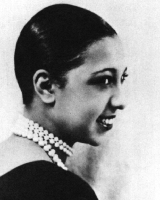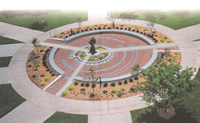
Josephine Baker
is honored with a Brick from Lowe Criner.
 She posed for the world-famous artist Picasso, and was adored by the well-known French woman writer Colette as "the most beautiful panther" and "little brown daughter." She starred in a movie, and was seen strolling the streets of Paris with her diamond-collared pet leopard. The Pasha of Marrakesh temporarily sheltered her during World War II in his exquisite Turkish palace. She christened elephants at the French Circus with champagne alongside actor Maurice Chevalier. She danced nearly naked on Parisian stages, and was so adored by French children that they bought thousands of black dolls made in her image. Newspapers called her "the most photographed girl in the world." White multimillionaire Jean Lion taught her to fly, and proposed marriage to her in mid-air. She became an outspoken supporter of South American dictator Juan Peron. She joined the Women's Auxiliary of the Free French Air Force at the end of World War II, and won her lieutenancy by secret intelligence work against Hitler's regime. She also helped to get several Jewish musicians and their families out of Europe, literally saving their lives. She adopted twelve children of different racial backgrounds to prove to the world that humanity is a family. She was Josephine Baker, and she had entered into this life an American who lived in abject poverty.
She posed for the world-famous artist Picasso, and was adored by the well-known French woman writer Colette as "the most beautiful panther" and "little brown daughter." She starred in a movie, and was seen strolling the streets of Paris with her diamond-collared pet leopard. The Pasha of Marrakesh temporarily sheltered her during World War II in his exquisite Turkish palace. She christened elephants at the French Circus with champagne alongside actor Maurice Chevalier. She danced nearly naked on Parisian stages, and was so adored by French children that they bought thousands of black dolls made in her image. Newspapers called her "the most photographed girl in the world." White multimillionaire Jean Lion taught her to fly, and proposed marriage to her in mid-air. She became an outspoken supporter of South American dictator Juan Peron. She joined the Women's Auxiliary of the Free French Air Force at the end of World War II, and won her lieutenancy by secret intelligence work against Hitler's regime. She also helped to get several Jewish musicians and their families out of Europe, literally saving their lives. She adopted twelve children of different racial backgrounds to prove to the world that humanity is a family. She was Josephine Baker, and she had entered into this life an American who lived in abject poverty.
She was born in East St. Louis, IL in 1906, the illegitimate daughter of a domestic worker and a flamboyant whorehouse drummer. Her life began in humiliating poverty. As a child she was a scavenger for food in the garbage cans of Chestnut Valley, St Louis's notorious tenderloin district which was also known as "the cradle of ragtime." Her father left her mother shortly after she was born, and Josephine's resemblance to her father became a distressing reminder to her mother of the man who no longer wanted her. Eventually her mother married another man, and Josephine was shuttled amongst relatives in South Carolina because she was embarrassingly "too light-skinned" for the newly formed family to openly appear with her half-siblings. By age eight, she was a domestic worker in a white woman's home. There she was severely abused and badly burned by her employer when, after using too much soap in the laundry, her employer plunged her hands into boiling water. Even after that she was not allowed to stay with her family, and was hired out to work in the home of another white woman. She had to leave there after her mistress's husband began to show a sexual interest in her.
She continued to survive by scavenging for coal in the railroad freight yards of Union Station. The most agile of the band of children scavenging there, she jumped on top of the railroad cars and threw down pieces of coal to the others, who waited beneath her with sacks. She also led teams of children to the rich parts of town and went door-to-door asking for work. She seldom got any.
When Josephine was 11 years old, the East St. Louis race riot of 1917 stamped itself in her memory of childhood traumas. During this riot, whites went rampaging through the black ghetto of East St. Louis, setting fire to buildings indiscriminately. Thirty-nine blacks were killed and thousands left homeless. Josephine always remembered standing at the end of the Mississippi Bridge and watching blacks run to safety, as panic-stricken as rampaging animals. She heard stories of horrible atrocities - pregnant women ripped open by knife-wielding whites, black men burned. It made such an impression on her that when she told the story of her life, she sometimes began with the East St. Louis race riot as though it were her earliest memory.
By age 16, she had already been married twice in an attempt to find a place to call home. That such a childhood produced an American expatriate is not surprising. What better response to the fear of exile than voluntary expatriation? At 19, Josephine Baker left America for the rest of the world. All she had was a talent to dance and a desire to survive.
In 1925, when she arrived in France, Paris was in love with the "primitive." Josephine appeared as a dancer in The Reeve Negre. "La Baker" made her entrance clowning like a strange creature from another world. She literally waddled onstage, knees bent and spread apart. Her stomach was sucked in, her body contorted. To the Parisians, she looked more like an animal than a human being - a weird cross between a kangaroo, a bicyclist, and a machine gun. She was dressed in a torn shirt and a pair of ragged shorts, her lips were painted in the style of blackface. Her skin seemed to be the color of bananas, and her short hair was plastered to her head. She screwed up her face, crossed her eyes, puffed out her cheeks, and made noises in a high-pitched voice. Then she did the splits. She shook and shimmied constantly, moving like a snake. Because of her dance, the music seemed to come from her body. Finally, she left the stage on all fours, rear end in the air.
Parisian audiences questioned; "Is it a man? Is it a woman? Is it an animal? Is it awful or marvelous? Black or white?" She epitomized ambiguity. She presented a revelation of possibilities in human nature they hadn't expected. Paris loved her because she came to represent that the animal inside of every human being wasn't a dark, tormented savage. The "animal" was good-natured, lively, sexy rather than sensual, and above all funny.
Some say that Josephine Baker's life was "more French than the French." She lived in France for the rest of her life, often touring Europe, and during the height of the Jazz Age was know as the "Jazz Cleopatra." Her flamboyant style and patriotic nature made her an unforgettable phenomenon for the next 50 years.
The following is a poem by Josephine Baker written in 1930:
At the age of eight I was already working to calm the hunger of my family.
I have suffered: hunger, cold.
I have a family
They said I was homely
That I danced like an ape
Then I was less homely - Cosmetics
I was hooted
Then I was applauded - the crowd
I continued to dance - I loved jazz
I continued to sing - I loved sadness; my soul is sick
I had an opportunity - Destiny
I had a mascot - a panther - Ancestral superstition
I made a tour of the world - In third class and in Pullman
I am moral
They said I was the reverse
I do not smoke - I have white teeth
I do not drink - I am an American
I have a religion
I adore children
I love flowers
I aid the poor - I have suffered much
I love the animals - they are the sincerest
I sing and dance still - Perseverance
I earn much money - I do not love money
I save my money - for the time when I am no longer an attraction.
She was buried on April 15, 1975. Her nationally televised state funeral was almost unprecedented for an entertainer. It was held in the Church of the Madeline, where Napoleon had been crowned Emperor of France years before. Twenty thousand people crowded the streets outside the church, spilling back almost the Place de la Concorde. In the crowd was Sophia Loren, Princess Grace of Monaco, the Mayor of Paris, the Minister of Culture, the Chancellor of the Legion of Honor, and former Prime Minister deGaulle's son-in-law (who was also Commander-in-Chief of the French Army.) Her flag-draped coffin was carried through an honor guard of two dozen flags, as is done in funerals for French Army veterans. Inside the coffin, Josephine Baker lay without makeup. Her sister had laid out, and had insisted on that, as well as the closed coffin. There would be no photographs taken of Josephine Baker dead. She would have wanted people to remember her alive.
References: Haney, Lynn. Naked at the Feast. Dodd, Mead, and Company, 1981. Rose, Phyllis. Jazz Cleopatra. Doubleday, 1989
Submitted by WSU sophomore Lowe Criner
September 17, 1998










